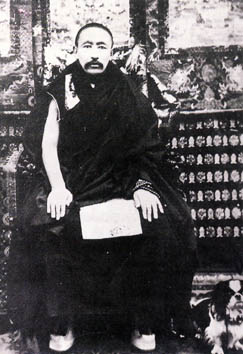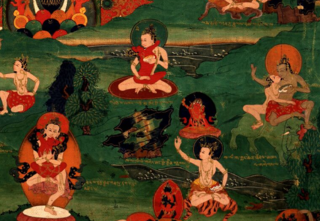
Tibetan Buddhism is a form of Buddhism practiced in Tibet, Bhutan and Mongolia. It also has a sizable number of adherents in the areas surrounding the Himalayas, including the Indian regions of Ladakh, Sikkim, and Arunachal Pradesh, as well as in Nepal. Smaller groups of practitioners can be found in Central Asia, Xinjiang, Inner Mongolia, and some regions of Russia, such as Tuva, Buryatia, and Kalmykia.

Nikolai Konstantinovich Rerikh, better known as Nicholas Roerich, was a Russian painter, writer, archaeologist, theosophist, philosopher, and public figure. In his youth he was influenced by Russian Symbolism, a movement in Russian society centered on the spiritual. He was interested in hypnosis and other spiritual practices and his paintings are said to have hypnotic expression.

Kālacakra is a polysemic term in Vajrayana Buddhism as well as Hinduism that means "wheel of time" or "time cycles". "Kālacakra" is also the name of a series of Buddhist texts and a major practice lineage in Indian Buddhism and Tibetan Buddhism. The tantra is considered to belong to the unexcelled yoga (anuttara-yoga) class.
In Tibetan Buddhist tradition, Shambhala, also spelled Shambala or Shamballa, is a spiritual kingdom. Shambhala is mentioned in the Kalachakra Tantra. The Bon scriptures speak of a closely related land called Tagzig Olmo Lung Ring.

Thubten Choekyi Nyima (1883–1937), often referred to as Choekyi Nyima, was the ninth Panchen Lama of Tibet.

Burkhanism or Ak Jang is an indigenist new religious movement that flourished among the Altai people of Russia's Altai Republic between 1904 and the 1930s. The Russian Empire was suspicious of the movement's potential to stir up native unrest and perhaps involve outside powers. The Soviet Union ultimately suppressed it for fear of its potential to unify Siberian Turkic peoples under a common nationalism.

Buddhism is the largest religion in Mongolia practiced by 51.7% of Mongolia's population, according to the 2020 Mongolia census. Buddhism in Mongolia derives much of its recent characteristics from Tibetan Buddhism of the Gelug and Kagyu lineages, but is distinct and presents its own unique characteristics.

In Vajrayana Buddhism, the Ādi-Buddha is the "First Buddha" or the "Primordial Buddha". Another common term for this figure is Dharmakāya Buddha.

The Altai people, also the Altaians, are a Turkic ethnic group of indigenous peoples of Siberia mainly living in the Altai Republic, Russia. Several thousand of the Altaians also live in Mongolia and China but are not officially recognized as a distinct group and listed under the name "Oirats" as a part of the Mongols, as well as in Kazakhstan where they number around 200. For alternative ethnonyms see also Tele, Black Tatar, and Oirats. During the Northern Yuan dynasty, they were ruled in the administrative area known as Telengid Province.
In the late 1990s, some journalists used the expression "New Great Game" to describe what they proposed was a renewed geopolitical interest in Central Asia based on the mineral wealth of the region.

Ja Lama was an adventurer and warlord of unknown birth and background who fought successive campaigns against the rule of the Qing dynasty in western Mongolia between 1890 and 1922. He claimed to be a Buddhist lama, though it is not clear whether he actually was one, as well as a grandson and later the reincarnation of Amursana, the Khoid-Oirat prince who led the last great Mongol uprising against the Qing in 1757. He was one of the commanders of Mongolian forces that liberated Khovd city from Qing control in 1912.

Lobsang Tubten Jigme Gyatso (bot=བློ་བཟང་ཐུབ་བསྟན་འཇིགས་མེད་རྒྱ་མཚོ་), officially the 8th Arjia Hotogtu(bot=ཨ་ཀྱཱ་ཧོ་ཐོག་ཐུ།), born 1950 in Haiyan County, Qinghai) is one of the most prominent Buddhist teachers and lamas to have left Tibet. At age two, Arjia Rinpoche was recognized by Choekyi Gyaltsen, 10th Panchen Lama as the 20th Arjia Danpei Gyaltsen, the reincarnation of Je Tsongkhapa's father, Lumbum Ghe, the throne holder and abbot of Kumbum Monastery. He has trained with lineage teachers, such as the 14th Dalai Lama, the 10th Panchen Lama, and Gyayak Rinpoche—from whom he received many sacred teachings and ritual instructions.

Shambhala Training is a secular approach to meditation and a new religious movement developed by Tibetan Buddhist teacher Chögyam Trungpa Rinpoche and his students. It is based on what Trungpa calls Shambhala Vision, which sees enlightened society as not purely mythical, but as realizable by people of all faiths through practices of mindfulness/awareness, non-aggression, and sacred outlook.
Manjushrikirti or Manjughoshikirti is a name which refers to different figures in Indian Buddhism.

Agvan Lobsan Dorzhiev was a Russian-born monk of the Gelug school of Tibetan Buddhism, sometimes referred by his scholarly title as Tsenyi Khempo. He was popularly known as the Sokpo Tsеnshab Ngawang Lobsang to the Tibetans.

The occupation of Outer Mongolia by the Beiyang government of the Republic of China after the revocation of Outer Mongolian autonomy began in October 1919 and lasted until 18 March 1921, when Chinese troops in Urga were routed by Baron Roman von Ungern-Sternberg's White Russian and Mongolian forces. These, in turn, were defeated by the Red Army and its Mongolian allies by June 1921.

In part of the Indo-Tibetan Vajrayana Buddhist tradition, thirty-two Kings of Shambhala reside in a mythical kingdom.

Karmamudrā is a Vajrayana Buddhist technique which makes use of sexual union with a physical or visualized consort as well as the practice of inner heat (tummo) to achieve a non-dual state of bliss and insight into emptiness. In Tibetan Buddhism, proficiency in inner heat yoga is generally seen as a prerequisite to the practice of karmamudrā.

Gleb Ivanovich Bokii was a Soviet Communist political activist, revolutionary, and paranormal investigator in the Russian Empire. Following the October Revolution of 1917, Bokii became a leading member of the Cheka, the first Soviet secret police, and later of the OGPU and NKVD.

Buddhism in Buryatia, a region in Siberia, Russia, has a deep-rooted history dating back to the 17th century when Tibetan Buddhism first arrived in the area. Initially adopted by ethnic groups like the Selenga and Zede Buryats, Buddhism gradually spread throughout the Transbaikal region. In 1741, it gained formal recognition as an official religion in the Russian Empire, with the establishment of Buddhist monastic universities known as datsans. Despite facing significant challenges during the Soviet era, including persecution and the closure of religious institutions, Buddhism in Buryatia has persisted and experienced a revival in the post-Soviet period.

















